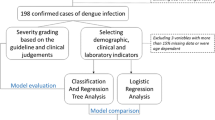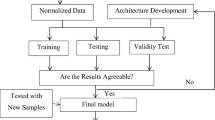Abstract
This paper presents a new approach to diagnose and classify early risk in dengue patients using bioelectrical impedance analysis (BIA) and artificial neural network (ANN). A total of 223 healthy subjects and 207 hospitalized dengue patients were prospectively studied. The dengue risk severity criteria was determined and grouped based on three blood investigations, namely, platelet (PLT) count (less than or equal to 30,000 cells per mm3), hematocrit (HCT) (increase by more than or equal to 20%), and either aspartate aminotransferase (AST) level (raised by fivefold the normal upper limit) or alanine aminotransferase (ALT) level (raised by fivefold the normal upper limit). The dengue patients were classified according to their risk groups and the corresponding BIA parameters were subsequently obtained and quantified. Four parameters were used for training and testing the ANN which are day of fever, reactance, gender, and risk group’s quantification. Day of fever was defined as the day of fever subsided, i.e., when the body temperature fell below 37.5°C. The blood investigation and the BIA data were taken for 5 days. The ANN was trained via the steepest descent back propagation with momentum algorithm using the log-sigmoid transfer function while the sum-squared error was used as the network’s performance indicator. The best ANN architecture of 3-6-1 (3 inputs, 6 neurons in the hidden layer, and 1 output), learning rate of 0.1, momentum constant of 0.2, and iteration rate of 20,000 was pruned using a weight-eliminating method. Eliminating a weight of 0.05 enhances the dengue’s prediction risk classification accuracy of 95.88% for high risk and 96.83% for low risk groups. As a result, the system is able to classify and diagnose the risk in the dengue patients with an overall prediction accuracy of 96.27%.








Similar content being viewed by others
References
Annual Report, WHO Collaborating and Research (1998) Dengue haemorrhagic fever. Department of Medical Microbiology, Kuala Lumpur, Malaysia
Balmaseda A et al (2006) Serotype-specific differences in clinical manifestations of dengue. Am J Trop Med Hyg 3(74):449–456
Basheer IA, Hajmeer M (2000) Artificial neural networks: fundamentals, computing, design, and application. J Microbiol Methods 43:3–31
Chua MN, Molanida R, De Guzman M, Laberiza F (1993) Prothrombin time and Partial thromboplastin time as a predictor of bleeding in patient with DHF. Southeast Asian J Trop Med Public Health
Chungue E, Boutin JP, Roux J (1989) Significance of IgM titration by an immunoenzyme technic for the serodiagnosis and epidemiological surveillance of dengue in French Polynesia. Res Virol 3(140):229–240
Faisal T, Taib MN, Ibrahim F (2010) Reexamination of risk criteria in dengue patients using the self-organizing map. Med Biol Eng Comput 48:293–301
Faisal T, Taib MN, Ibrahim F (2010) A noninvasive intelligent approach for predicting the risk in dengue patients. Expert Syst Appl 37:2175–2181
Faisal T, Taib MN, Ibrahim F (2010) Neural network diagnostic system for dengue patients risk classification. J Med Syst (in press)
Fang R et al (1982) The dengue epidemic in Malaysia. Epidemiological, serological and virological aspects. Southeast Asian J Trop Med Public Health 1984:15–51
Goh YS, Tan EC (1994) Pruning neural networks during training by backpropagation. TENCON 94. IEEE region 10’s ninth annual international conference
Gubler DJ (1998) Dengue and dengue hemorrhagic fever. Clin Microbiol Rev 11:480–496
Gubler DJ (2002) Epidemic dengue/dengue hemorrhagic fever as a public health, social and economic problem in the 21st century. Trends Microbiol 10:100–103
Hales S, de Wet N, Maindonald J, Woodward A (2002) Potential effect of population and climate changes on global distribution of dengue fever: an empirical model. Lancet 360:830–834
Halstead BS (1989) Antibody, macrophages, dengue virus infection, shock, and hemorrhagic: a pathogenetic cascade. Rev Infect Dis 11:830–839
Harris E et al (2000) Clinical, epidemiologic, and virologic features of dengue in the 1998 epidemic in Nicaragua. Am J Trop Med Hyg 63:5–11
Haselsteiner E, Pfurtscheller G (2000) Using time-dependent neural networks for EEG classification. IEEE Trans Rehabil Eng 8:457–463
Haykin S, Neural networks (1994) A comprehensive foundation. Macmillan, New York
Ibrahim F (2005) Prognosis of dengue fever and dengue hemorrhagic fever using bioelectrical impedance. Ph.D. Thesis, Department of Biomedical Engineering, Faculty of Engineering, University of Malaya
Ibrahim F, Ismail NS, Taib MN, Wan Abas WAB (2004) Modeling of hemoglobin in dengue fever and dengue hemorrhagic fever using bioelectrical impedance. Physiol Meas 25:607–615
Ibrahim F, Taib MN, Wan Abas WAB, Chan CG, Sulaiman S (2005) A novel approach to classify risk in dengue hemorrhagic fever (DHF) using bioelectrical impedance. IEEE Trans Instrum Meas 54(1):237–244
Ibrahim F, Taib MN, Wan Abas WAB, Chan CG, Sulaiman S (2005) A novel dengue fever (DF) dengue and hemorrhagic fever (DHF) analysis using artificial neural network. Computer Methods Programs Biomed 79:273–281
Ibrahim F, Taib MN, Wan Abas WAB, Chan CG, Sulaiman S (2008) A new approach to classify risk in dengue infection using bioelectrical impedance analysis (BIA). World Health Org Dengue Bull 31:58–74
Jaffrin MY, Morel H (2009) Extracellular volume measurements using bioimpedance spectroscopy-Hanai method and wrist-ankle resistance at 50 kHz. Med Biol Eng Comput 47:77–84
Jaffrin MY, Fenech M, Moreno MV, Kieffer R (2006) Total body water measurement by a modification of the bioimpedance spectroscopy method. Med Biol Eng Comput 44(10):873–882
John T, Wei ZZ, Barnhill SD, Madyastha R (1998) Understanding artificial neural networks and exploring their potential applications for the practicing urologist. Urology 52:161–172
Kuo CH, Tai DI, Chang-Chien CS, Lan CK, Chiou SS, Liaw YF (1992) Liver biochemical test and dengue fever. Am J Trop Med Hyg 3(47):265–270
Lam SK, Devi S, Pang T (1987) Detection of specific IgM in dengue infection. Southeast Asian J Trop Med Public Health 4(18):532–538
Ministry of Health Malaysia (2009). http://www.moh.gov.my/MohPortal/newsFull.jsp?action=load&id=401. Assessed 5 Jul 2009
Monath TP (1994) Dengue: the risk to developed and developing countries. Proc Natl Acad Sci USA 91:2395–2400
More FW (1904) Observations on dengue fever in Singapore. J Malaya Branch Br Med Assoc 1:24–29
Negnevitsky M (2002) Artificial intelligence, a guide to intelligent system. First Edition, Pearson education. ISBN: 0201711591
Nimmannitya S (1987) Clinical spectrum and management of dengue haemorrhagic fever. Southeast Asian J Trop Med Public Health 18:392–397
Paterno AS, Stiz RA, Bertemes-Filho P (2009) Frequency-domain reconstruction of signals in electrical bioimpedance spectroscopy. Med Biol Eng Comput 47(10):1093–1102
Rebecca George MD (1992) Current status of the knowledge of dengue/DHF/DSS in Malaysia: clinical aspects. 15th Annual Convention of the Philippine Society foe Microbiology and Infectious Diseases
Rigaud B, Morucci JP, Chauveau N (1996) Bioelectrical impedance techniques in medicine part I: bioimpedance measurement second section: impedance spectrometry. In: Bourne JR (ed) Critical reviews in biomedical engineering. Begell House, New York, vol 24
Rudnick A et al (1965) Mosquito borne haemorrhagie fever in Malaysia. Br Med J 1:1269–1272
Sinha SK, Fieguth PW (2005) Projection neural network model for classification of pipe defects. J Autom Constr 15(1):73
Sun M, Sclabassi RJ (2000) The forward EEG solutions can be computed using artificial neural networks. IEEE Trans Biomed Eng 47:1044–1050
Wallace Hazel G et al (1980) Dengue haemorthagic fever in Malaysia 1973 epidemic. Southeast Asian J Trop Med Public Health 11:1–12
Weigend AS, Rumelhart DE, Huberman BA (1991) Generalization by weight elimination with applications to forecasting. In: Lippmann R, Moody J, Touretzky D (eds) Advances in neural information processing 3, pp 875–882
World Health Organization (1997) Dengue haemorrhagic fever: diagnosis, treatment, prevention and control, 2nd edn. WHO, Geneva
Acknowledgments
This research was supported by University of Malaya, Sultan Iskandar Johore Foundation, and Ministry of Science, Technology and Innovation (MOSTI) (E-Science Fund 11-02-1014).
Author information
Authors and Affiliations
Corresponding author
Rights and permissions
About this article
Cite this article
Ibrahim, F., Faisal, T., Mohamad Salim, M.I. et al. Non-invasive diagnosis of risk in dengue patients using bioelectrical impedance analysis and artificial neural network. Med Biol Eng Comput 48, 1141–1148 (2010). https://doi.org/10.1007/s11517-010-0669-z
Received:
Accepted:
Published:
Issue Date:
DOI: https://doi.org/10.1007/s11517-010-0669-z




